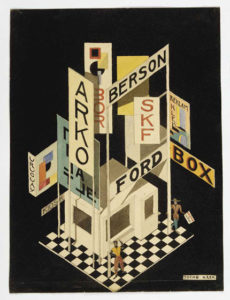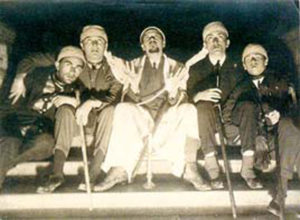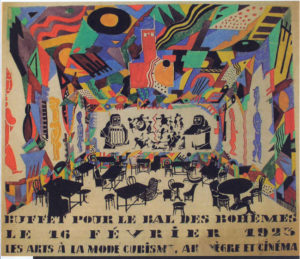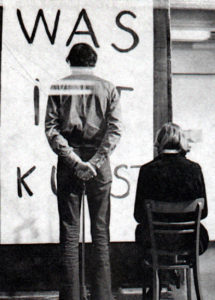PDF available here.
Ana Vujanović (2009-13)
It is commonplace or even commonsense that the bulk of knowledge that reaches the periphery is second-hand knowledge. And the periphery—that is us, Serbia, Southeast Europe, Yugoslavia, the Balkans. There is no irony here, for these regions are peripheral, provincial, and marginal with respect to the centres of the First World, Europe, the European Union, the Austro-Hungarian Empire, or the Ottoman Empire. For instance, let us briefly consider some prominent examples from Serbian twentieth-century art.[1] Dadaism reached us through Dragan Aleksić, his studies in Prague and connections with the Dadaists circles there. Eurhythmics and Laban’s method arrived here by way of the gymnastic dance workout and dance practice of Maga Magazinović, who studied with Max Reinhardt and Rudolf Steiner. Early conceptual art arrived mostly with Hungarian magazines, thanks to the Hungarian minority in Vojvodina, Serbia’s northern province. Still later, Tanztheater reached us through the modern ballet of Sonja Vukićević and theatre anthropology of the 1990s through a few local figures who studied with Eugenio Barba at Odin Teatret. And today, we also have our own versions of new British drama and contemporary—especially so-called conceptual—dance as the predominant practices on the contemporary performing arts scene…[2]
Let us retrace the post-war period step by step. During the socialist era, the Yugoslav art scene of the 1950s and ’60s was regulated through a system of official (state) mediators between the Eastern and Western scenes. And following this period of “cultural exchange programmes” planned by the state—which included touring big, representative productions by the national theatres—several curated international festivals emerged during the late 1960s and ’70s, such as BITEF (Belgrade International Theatre Festival: New Tendencies).[3] These mediators offered occasional flashes of firsthand insight into the international art scene. At BITEF, Yugoslav audiences could see works by Jerzy Grotowski, Robert Wilson, Performance Group, Living Theater, Pina Bausch, La Mamma, Tadeusz Kantor, Susanne Linke, Peter Brook, Wim Vandekeybus, René Pollesch, Anne Teresa De Keersmaeker, and many others. But was it really so? To clarify the situation, I will mention some additional details, such as the fact that Anne Teresa De Keersmaeker only came to BITEF in 2005 and Meg Stuart in 2008, while the Wooster Group, or Jérôme Bel, Xavier Le Roy, Boris Charmatz, Vera Mantero, and other prominent contemporary dance makers have yet to come. However, this sort of limitation is inevitable, since the role of the mediator (selector, programmer, or curator) does not even entail a neutral facilitation of direct insights, but planning, selecting, and representing. Therefore, even that apparent firsthand knowledge was, strictly speaking, second-hand: it was a sort of knowledge where someone else was making the decisions regarding its occurrence, visibility, context, and even availability.
The 1990s brought a new set of problems and second-hand knowledge achieved a special status in our social context. The breakup of Yugoslavia and the ensuing civil wars, along with the impoverishment, isolation, and international sanctions imposed against Serbia and Montenegro, made second-hand knowledge almost the only option in the region. Entire generations of theatre directors, theorists, performers, and choreographers routinely acquired their knowledge of the contemporary international scene from illegally photocopied foreign books, pirated video recordings, and even by updating, imaginarily, art books that had been published in the 1970s and ’80s. We used to call that “paper reality”.
And today, when I and many of us who were basically educated in that way, take part in the international artistic and theoretical context, it is a good moment to reconsider the notion of second-hand knowledge. Is it really so bad? Does it make me and us weak? Does it keep us behind? Does it make us unreliable? Or not? Or what?
* * *
Epistemologically speaking, second-hand knowledge is a mediated, unempirical type of knowledge, gained without direct insight into the subject. For instance, while researching a topic is a way of gaining firsthand knowledge, hearing or reading someone else’s account of the same topic (lecture, report, or presentation) is a way of acquiring second-hand knowledge. Firsthand knowledge is gained through perception and experience; second-hand knowledge by believing what someone else tells us.
In art, we often obtain second-hand knowledge from acknowledged authorities, whether or not they have official authorisation, such as theorists, critics, recognised artists, and professors, or we simply trust them, because they are our peers, well-informed persons, and so on. In many cases—traditionally, in fact—artistic knowledge is transferred as a set of techné through the disciples or followers of a particular school, master, or initiator of a paradigm. In addition, perhaps the most common form of second-hand knowledge of art is “knowledge from books”, nowadays including electronic formats and web sources as well. It is non-empirical knowledge acquired from written sources depicting, describing, or explaining certain artistic phenomena, works, or events, such as scholarly literature, catalogues, booklets, reviews, etc.
In the domain of religion, second-hand knowledge is typically perceived as basic knowledge. Its validity rests on the fact that in most religions the source is absent and therefore supplanted by an unconditional trust in its mediators: the first disciples, scribes of the holy scriptures, and then priests. An important example, or, rather, an exception that confirms the rule, might be found in Saint Augustine’s Confessions. His internal struggle was driven by the fact that, as a formerly pagan thinker, he could not bear to rely on second-hand knowledge only, as was common in Christianity. He was therefore desperately seeking knowledge at first-hand: to obtain answers on God from God himself. The magnificence of his struggle, from a Christian point of view, lies precisely in the fact that he was struggling against his own disbelief.
In law and jurisprudence, second-hand knowledge plays a major role, but at the same time, its status is highly ambivalent: it is necessary, but its credibility is always subject to doubt. A typical example is testimony. Every testimony constitutes second-hand knowledge, because it is a story told only by a witness, but at the same time, it can acquire the status of a “performative”, to which we assign “juridical” power as if it had it in itself.[4] Namely, its illocutionary dimension owes exactly to the protocol and conventional situation in which it is performed and therein lies its power, as well as its weakness. A characteristic situation is the trial, in which a witness’s performative testimony gains the status of a statement that is constitutive of the reconstruction of the event, under the obligation to tell the truth, a promise that may or may not be kept. More broadly, one finds this function of testimony in media reports, which are based on the premises of objectivity and credibility of journalism, even though they are increasingly doubted, as well as in everyday communication, whose performativity rests on our voluntary trust in the person telling us about an event, for example, an authority or a friend.[5] Elisabeth Fricker, who has analysed the differences between perception and testimony, conceives of the latter as a paradigm of second-hand knowledge that characterises much of our process of learning:
One issue concerns the depth and extent of our epistemic dependence on testimony, as we may label this broad epistemic source: Do we have any knowledge at all that is free of epistemic dependence on what we have learned from others? …
Conceptually speaking, if not epistemically, we climb up the ladder of testimony, to then throw it away. Mummy saying “red” was how I learned what is called “red”. But as I become a master of folk physics and folk psychology, I appreciate that Mummy’s saying something is red is one thing, its being so another—even if she is in fact always truthful and accurate.[6]
Keeping Fricker’s thesis in mind, I would move now to the terrain of everyday speech. There, second-hand knowledge has negative connotations, meaning: unverified knowledge, knowledge that is not based on factual insight, implying a lack of basic understanding of the facts, etc. I would ponder this a little, bearing in mind that common sense is nothing but doxa, an internalised pattern of ideologically instilled ways of thinking. In terms of epistemology, these negative connotations indicate our faith in objective, positive knowledge, gained in a direct, empirical way: by perception and factual insight, experience, and analysis. And this is exactly the definition of firsthand knowledge, with its imperatives of objectivity, neutrality, and positivity. From that viewpoint, all interpretation is undesirable, because it distorts the “image of reality” as it really is. However, this everyday use of the term is neither naïve nor simply inaccurate. We should realise that it has been tied firmly to the basic ideology of modern Western epistemology, ever since it gave preference to scientific insight over all other types of knowledge—religious, intuitive, or artistic. On the other side, there is the entire legacy of twentieth-century relativist and constructivist theory in the social sciences and humanities, indicating that all experience or firsthand knowledge is subject to both pre-existing social and ideological elaborations of the object of perception and our own interpretations determined by our own positioning, social context, interests, and the ideology operating in our cognitive political unconscious. Such arguments can be traced back even to Marxist theory, followed by the Frankfurt school, then hermeneutics, post-structuralism, and cultural studies. In these theoretical frameworks, second-hand knowledge is both important and necessary, because it enlarges, complements, and transforms our experience, enabling us to gain abundant insight into reality as we know it, even when we are not prepared to acquire it at a given moment.
Given the fact that second-hand knowledge is not based on personal experience or perception but rather communicated to us, one of its essential aspects is the social situation. In his Second-hand Knowledge, Patrick Wilson has delineated a social epistemology that centres on the notion of “cognitive authority”.[7] In the context of the information society—characterised by a hyper-production of information—Wilson analyses the generation of cognitive material in an individual and its relationship with expertise in knowledge industry and control of (the content of) information. Although he maintains a dichotomy between first-hand and second-hand knowledge, Wilson at the same time blurs the boundaries between them by locating learning in general within social contexts and processes, of which we are sometimes aware and quite often are not. According to Wilson, cognitive authority is a function that always operates in the process of gaining knowledge in a social situation. In defining it, he tries to distinguish between, on the one hand, cognitive (or epistemic) authority, predicated on a claim to a certain kind of knowledge, such as that of a specialist, an expert on specific matters, and, on the other hand, “performatory” (or administrative) authority, entitled to a position, or authorised to, pass judgement, prescribe, and proscribe, like a judge.[8] However, the boundaries grow unstable when Wilson infers that cognitive authority depends on social perception and recognition. That is to say, there is no cognitive authority per se; instead, our recognition and appreciation of an authority relies on such things as its reputation, public opinion, and the performance of the speaker. At that point, a cognitive authority becomes “performatory” as well, so what differentiates cognitive from “performatory” authority may only be the latter’s official, administrative entitlement. Therefore, in my understanding, the most important question Wilson asks regarding cognitive authority may be formulated in the following way: given the abundance of “texts” (in the post-structuralist sense) that surround me, that are accessible to me, which one will become the authority as the source of knowledge (for me)? Which one will give me a key and enable me to systematise and understand these complex webs of signifying hyper-production? In the current context of the expansion of the Internet, with digital technologies enabling many other information and communication media, this question becomes ever more urgent and more complex, since the hyper-production of information and knowledge has been accompanied or even substituted by their hyper-exchange to a significant degree. In that situation—where we are overwhelmed by various net portals, platforms, blogs, generators, and aggregators—the source is “normally” lost and exchanging, recombining, editing, and sharing information is turning into knowledge production itself, thereby dismantling the division between first- and second-hand knowledge.
* * *
I hope that the argumentation that I have presented so far offers enough material for an attempt to reinterpret second-hand knowledge as a poetic term for the Yugoslav cultural scene and perhaps also to understand its negative connotations as a habit of everyday speech. On the one hand, as I pointed out above, that habit is rooted in modern Western epistemology, which has already been thoroughly examined and contested, while on the other, it reductively and paradoxically refers to practices of learning that even those who speak of second-hand knowledge as a negative term use regularly. For instance, if one reverses the ideological lens, one can clearly see that illegally shared and photocopied books or pirated VHS tapes, CDs, and DVDs are not restricted to this context of periphery in general, but are used by millions of “ordinary consumers” worldwide, as well as leftist circles in the West and their cultural-artistic scene, from Pirate Cinema Berlin to Pirate Bay and numerous free online libraries, with the purpose of resisting the neoliberal market of art and culture and encouraging the principles of sharing and distributing knowledge in alternative ways.
Although we could not quite conclude from the foregoing deconstruction that second-hand knowledge is somehow superior to firsthand knowledge—nor did I intend merely to invert the binary—we may conclude that, first, second-hand knowledge is not in any way specific to marginal(ised) artistic and cultural contexts, but rather, exists in the East and the West alike, as a regular and common type of knowledge. And second, following the entire corpus of contemporary theory in the social sciences and humanities from the 1960s on, we can also infer that there is no satisfying epistemic argument for discarding second-hand knowledge as somehow less authentic, objective, and reliable than firsthand knowledge.
When we contest these dichotomies in this way, it seems that the real reason why second-hand knowledge has retained its predominantly negative connotation and substantialising link to cultural peripheries lies elsewhere. In my view, that reason could only be found in social categories, the categories of having opportunities and the privilege to access the real, or perhaps always imaginary, source, which—tautologically—itself marks the centre. Thus, whenever we use the term “second-hand knowledge” in this way, we should be aware of, and take responsibility for, its ideological legacy and stake in cognitive colonisation or internalised self-victimisation, which are merely two sides of the same coin. I am making this assertion because what is crucial in social terms is that this hierarchical relationship between firsthand and second-hand knowledge is a symptom that reflects and consolidates the hierarchical order of the centre and the periphery in the global process of knowledge production, distribution, and exchange. Therefore, saying that second-hand knowledge is a form of knowledge that is characteristic of the region of the former Yugoslavia has a negative connotation, because it places the region in a subordinate position with respect to the centre. In fact, it is only in this way that the periphery may be interpellated and become periphery, whereas—and here we can see how the circular logic of that tautology works—only as periphery it comes into the position of importing knowledge (concepts, technologies, information, paradigms, trends, etc.) with smaller or larger distortions and delays.
However, at the very end I would like “to turn the screw of interpretation” once more (paraphrasing Shoshana Felman). It is absolutely untrue that the only knowledge we have had in our context is second-hand knowledge. If you go back to the beginning of this text, you will see that my framework is precise enough: all the while, I have been referring only to knowledge coming from abroad, that is, from the centre to the periphery. But of course, quite apart from all that, there is also quite a bit of specific, firsthand knowledge that has been produced here. In this regard, for example, I might mention the Zenitist movement and its provocative figure of artistic disobedience called the “Balkan barbaric-genius”, in the context of the historical avant-garde; the “verbo-voco-visual” inter-media artistic practice from the 1960s; experiments in connecting workers’ self-management and (conceptual) art of the 1970s; and the Praxis School, the Marxist philosophical movement, among many other examples. However, this body of knowledge has almost never entered the global circulation of knowledge. This way, it mostly remains outside the Rancièrean “partition of the sensible” of the international artworld—as invisible images, voices that are not heard, or that are heard only as a bit of noise coming from the East.
And today, even as I try to reopen this question, yet again I must resort to a kind of second-hand knowledge—Western theoretical discourses. I must, because they form my discursive platform when I want it to become widely (that is, “internationally”) recognisable. And perhaps that is the only socially possible relationship between centre and periphery, however cynical that may sound. Nevertheless, there may be something “good” in all of that, something that reminds me of the Lacanian master/slave discourse in terms of constructing models of knowledge and social predications of the value assigned to knowledge. From this viewpoint, we could say that the discourse of the master is exactly that which puts the slave’s discourse at work, but whose labour will undermine it. Making a big leap here, I would remind us never to forget that the slave must speak both her own and the language of her master in order to survive (in a world mastered by the master), while the master, although his discourse is advantageous in all respects, and perhaps precisely because of that, always remains deprived of understanding the language of his slaves. What is at stake here is not at all the slaves’ secret gratification; rather, it is about reminding us of the permanent threat to the master discourse and its hegemonic symbolic matrix of truth, a threat that can neither be erased, nor stopped.
The work is licensed under CC-BY-NC-SA 3.0 Srbija: //http://www.creativecommons.org.rs//
The text was commissioned in 2008, for The East Dance Academy (EDA) lexicon of poetic terms Parallel Slalom, ed. by Bojana Cvejić and Goran Sergej Pristaš. So far the theses developed here have appeared as a lecture or an intervention, in different, hopefully improved versions, such as in Rijeka (CRO) in 2010, at the Performance Studies international #15 Follow up. The current version of the text is finally published in Parallel Slalom: A Lexicon of Non-Aligned Poetics, ed. by Bojana Cvejić & Goran Sergej Pristaš, Belgrade – Zagreb: TkH – CDU, 2013
PDF available here.




